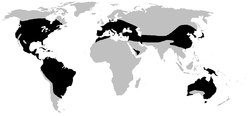
Hylidae
Background Information
SOS Children, an education charity, organised this selection. SOS Children has looked after children in Africa for forty years. Can you help their work in Africa?
| Tree frogs | |
|---|---|
 |
|
| Red-eyed Tree Frog, Agalychnis callidryas | |
| Scientific classification | |
| Kingdom: | Animalia |
| Phylum: | Chordata |
| Class: | Amphibia |
| Order: | Anura |
| Family: | Hylidae Rafinesque, 1815 |
| Genera | |
|
See text. |
|
 |
|
| Distribution of Hylidae (in black) | |
Hylidae are a family of frogs with tree dwelling adaptations, contained by the order Anura. The genera of this family include a diversity of frog species, many of which do not live in trees, but are terrestrial or aquatic. They mostly feed on insects and other invertebrates, but some larger species can feed on small vertebrates. The Cyclorana species are burrowing frogs that are able to live underground.
Types
The European tree frog, Hyla arborea, is common in the middle and south of North America, and range into Asia and North Africa. The species become very noisy on the approach of rain and are sometimes kept in confinement as a kind of barometer.
In North America there are many species of the Hylidae family, including Hyla versicolor, a species known as the grey tree frog, and Hyla cinerea, the American green tree frog. The spring peeper, Pseudacris crucifer, is also widespread in the eastern United States and is commonly heard on summer and spring evenings.
The tree frog is a popular name for several of the Hylidae. Hyla versicolor is the changeable tree frog, Trachycephalus lichenatus is the lichened tree frog, and Trachycephalus marmoratus the marbled tree frog.





